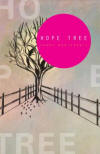Hope Tree
The front matter of Frank Montesonti’s Hope Tree asserts something interesting for an erasure formed from a how-to manual about pruning: “method / is unnecessary / to remove / the past season.” It is a fitting introduction to a book in which leniency and ruthlessness, and growth and death, are inexorably intertwined.
The front matter of Frank Montesonti’s Hope Tree asserts something interesting for an erasure formed from a how-to manual about pruning: “method / is unnecessary / to remove / the past season.” It is a fitting introduction to a book in which leniency and ruthlessness, and growth and death, are inexorably intertwined.
Montesonti’s work is an erasure of How to Prune Fruit Trees by horticulturalist R. Sanford Martin. Erasures—poems created from existing text by removing selected words and punctuation—are a kind of heavily pruned art, so it seems particularly meaningful that Montesonti chose a text about pruning from which to create Hope Tree. As with any erasure, it is interesting to consider how much of the original work is left in what is new, and how much of a work is inevitably unerasable. Montesonti’s finished work is very much about pruning, though it is pruning of a new sort—somber and metaphorical.
That Montesonti’s pruning of a text about pruning results in an erasure about pruning—even emotional or psychological pruning—might seem disappointing. The point of an erasure, it seems, is the wild surprise hiding inside, waiting to be rubbed open, waiting to be revealed. If a poet fails to trim enough, he risks winding up with something too close to the original text, and where is the wild wonder, then?
In Montesonti’s work, there are pages stripped of excess and exposition, as on one with just three lines: “be recognized / almost as though / burned by fire.” There also are surprises—enough to make this book feel like the revelation that poetry ought to be. But there are, as well, sections that feel insufficiently thinned. Even his nine-line erasure used as the forward might finish two lines too late:
I have hesi-
tated
I was aware
I have tried to make
my instructions simple
providing one knows what
he is pruning for.
This commercial orchardist
owner of a few trees.
Admittedly, this does a disservice to Montesonti’s work. The lines are compressed, and the quote, consequently, is missing the ragged beauty of Montesonti’s erasure. Much of the strength and mystery of any erasure is in the white space. Nothing is entirely flush or centered, lines are staggered, and the space between lines—the vast whiteness—has a kind of musical silence. White space always matters in poetry, of course, but it seems to matter more in erasures. One page in Montesonti’s book has only two words: “ornamental” at the top, and “indefinitely” at the bottom. It feels like a kind of manifesto.
What Montesonti creates with the language he keeps, and with the white space he produces and protects, is an exploration of how we grow and why we blossom. Inevitably, what he creates is also an unflinching, unsentimental statement about the importance of removing what is dead in our lives. This, naturally, leads to a fair question: Where is the promised hope in a book which has moments such as this: “every winter / is simple / cleared away and burned”? Or this: “the sour types / are naturally very tall growers.” Where is the hope in a book that asserts the importance of “removing / the / least desirable” and later reasserts that Darwinian truth: “Remove the one which contributes / the least.” This work implores you to “Follow instructions / head down” and asks a reader to “consider / the dead / crossing branches, / rubbing one another / in an overcrowded manner.” Where is the hope in a book that concerns itself with blight and infection?
It is true that a kind of stern caution pervades much of this erasure. Over and over again, we are reminded that we must do that which is difficult. But hope, as Montesonti reveals it, is braided with the hard work of excising what is diseased or already dead. Hope is what remains after elimination, and what is renewed every season. Hope is given to us on a page with only nine words: “Valencia, There is time / to work your way inside.” And hope appears later in “an imaginary circle drawn around / the future.” There even is this imperative: “Keep / content as possible.”
Occasionally, there are inconsistencies in what Montesonti uncovers. Early on in his erasure, he reveals a lovely and fantastical image: “in the lower portion / blossom / the dead.” This specific hope is not corroborated elsewhere in the book, which seems, mostly, to assert the uselessness of what has died. There is a minor conflict, too, in the very act of pruning—in the tension between letting something become itself (“this work of individual shape”) and trying to control tangles and train everything “. . . into an / almost exact duplicate of all the others.”
Interestingly, Montesonti’s 84-page erasure about doing what is difficult ends in observation, with a two-line page: “live twig, and watch it / for a few minutes.” Here is the pleasure that comes after labor. Here is the satisfaction one sometimes feels after an act of severity, a word that has, in its beginning, the verb central to this book: sever. To end something is a kind of ruthlessness and a kind of hope. It is, quite often, the work of the orchardist, and the work of a human being. There is this to consider, and much else to savor, in Montesonti’s erasure.





